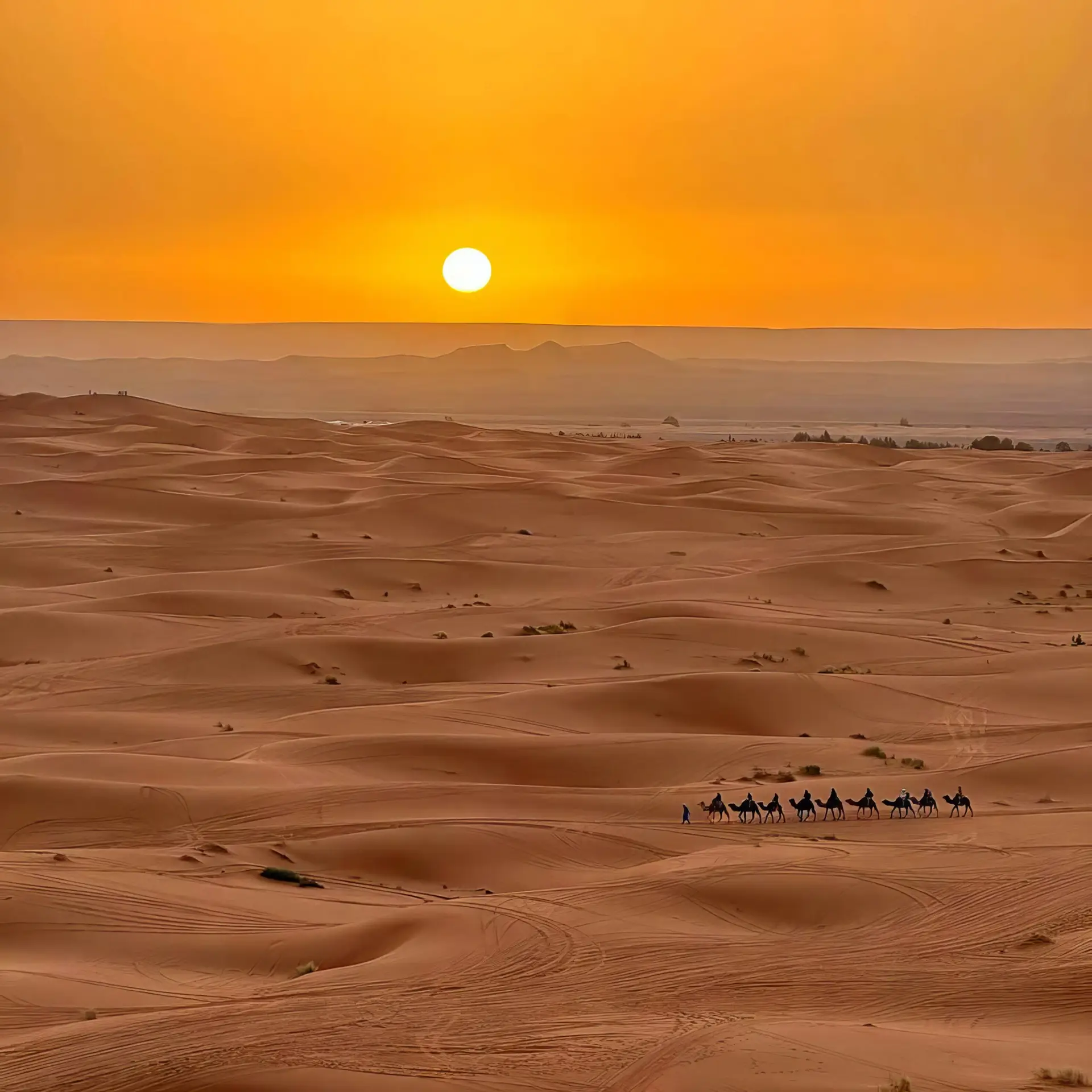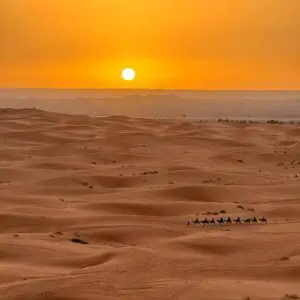What You Need to Know Before Visiting the Sahara
The Sahara Desert is one of the most awe-inspiring places on Earth. Stretching across 11 countries and covering over 9 million square kilometers, it’s a destination that captures the imagination with its endless sand dunes, star-filled skies, and ancient caravan routes. In Morocco, the Sahara is especially accessible and offers unforgettable experiences like camel trekking, sleeping in desert camps, and watching the sun rise over golden dunes.
But the Sahara is also an extreme environment, and traveling there requires preparation, awareness, and respect for its conditions. This guide will give you everything you need to know before visiting the Sahara Desert, particularly from Morocco, ensuring you stay safe, comfortable, and ready for the adventure of a lifetime.
1. Choose Your Entry Point Wisely
In Morocco, the two main gateways to the Sahara are Merzouga (Erg Chebbi) and Zagora (Erg Chigaga). Both offer desert experiences, but they are very different.
Merzouga (Erg Chebbi):
- The most famous and photogenic part of the Moroccan Sahara.
- Known for towering sand dunes that can reach up to 150 meters.
- Easier to access for first-time visitors.
- More commercialized, with a wide range of accommodation from budget camps to luxury tents.
Zagora (Erg Chigaga):
- Less touristy and more rugged.
- Requires longer travel, often with 4x4s to reach remote camps.
- More authentic desert experience with fewer crowds.
Tip: If you’re short on time, Merzouga is more accessible. If you’re seeking isolation and authenticity, head to Erg Chigaga.
2. Prepare for Extreme Temperatures
The Sahara is a land of extremes. Temperatures can soar above 45°C (113°F) during the day in summer, and plummet close to freezing at night, especially in winter.
What to Pack:
- Light, breathable clothing for daytime (long sleeves and pants protect from sunburn).
- Warm layers for the evening and early morning (it gets surprisingly cold).
- A headscarf or turban (often called a “cheche”) to shield yourself from sun, sand, and wind.
- Sunglasses, sunscreen, and lip balm—essentials for dry and sunny conditions.
- A good pair of walking shoes or hiking boots for camel rides and dune trekking.
Tip: Avoid dark colors which attract heat. Loose, light-colored clothing is ideal.
3. Camel Trekking: Beautiful but Not Easy
Camel rides are the quintessential Sahara experience. But be warned—it’s not a smooth journey.
What to Expect:
- Camels are tall, and mounting/dismounting can be awkward at first.
- The ride is bumpy, and your legs may get sore.
- Most treks last between 1 to 2 hours, though multi-day treks are available for the adventurous.
Tips for Comfort:
- Stretch before and after the ride.
- Use a scarf or shawl to create padding between you and the saddle.
- Stay hydrated—desert heat dehydrates you faster than you realize.
4. Stay Overnight in a Desert Camp
Spending a night under the Saharan sky is one of the most rewarding travel experiences in the world. Most travelers opt for a Berber camp—a setup that ranges from basic tents with communal toilets to luxury canvas suites with en-suite bathrooms and fine dining.
What’s Included:
- Camel ride to the camp.
- Dinner (usually tagine or couscous) and traditional music around a campfire.
- Sunrise and sunset dune excursions.
- Sometimes sandboarding or star-gazing activities.
Tip: Luxury camps may include running water, hot showers, and electricity—ask before booking. Budget camps can be quite basic; prepare accordingly.
5. Plan Your Travel Route Carefully
Most visitors to the Sahara start from Marrakesh or Fes. Travel to the desert takes time—expect 8 to 10 hours of driving, often split over two days with stops at the Atlas Mountains, Ait Benhaddou, or the Dades Valley.
Recommended Itinerary:
- Day 1: Marrakesh to Dades Gorge (overnight).
- Day 2: Dades Gorge to Merzouga (desert camp overnight).
- Day 3: Sunrise camel ride, return to Marrakesh or continue to Fes.
Tip: Don’t try to squeeze the desert into a one-day trip—it’s not worth the rushed experience. Three days minimum is ideal.
6. Travel with a Reputable Tour Operator
There are dozens of tour operators offering Sahara excursions in Morocco. But not all are reliable or transparent.
What to Look For:
- Clear itinerary with travel times and accommodation standards.
- Reviews from past customers (Google, TripAdvisor).
- Licensed and insured operators.
- Knowledgeable guides who speak your language.
Avoid: Tours that advertise “1-day Sahara desert trips” from Marrakesh. These typically only visit rocky pre-desert terrain near Zagora and not the real dunes.
7. Desert Photography: Timing Is Everything
The desert offers some of the most stunning photography opportunities in the world—if you know when and how to capture them.
Golden Hours:
- Sunrise and sunset—ideal for dramatic shadows and soft lighting.
- Blue hour—just after sunset or before sunrise for cool tones.
- Night sky—clear skies make it perfect for star photography and astrophotography.
Tips:
- Bring a tripod and extra batteries (charging options are limited).
- Use manual settings for better control over lighting conditions.
- Don’t forget to clean your lens frequently—sand is everywhere.
8. Health and Safety in the Sahara
Though safe, the Sahara demands respect. Conditions are harsh, and medical access is limited.
Safety Tips:
- Bring any necessary medications with you (pharmacies are not available in remote areas).
- Tell someone your travel plans if going independently.
- Carry extra water and snacks.
- Wear a hat and keep skin covered to avoid sunstroke.
Tip: Don’t rely on cell service or GPS. Many areas have no signal. Some camps use satellite phones for emergencies.
9. Cultural Sensitivity and Local Customs
The Sahara is home to Berber and Tuareg communities, and your desert experience will likely involve interaction with locals.
Be Respectful:
- Always ask before taking photos of people.
- Dress modestly (especially women).
- Accept hospitality but understand tipping is often expected after services.
Tip: A small phrasebook or learning a few Arabic/Berber greetings can go a long way in showing respect and building rapport.
10. Best Time to Visit the Sahara
Timing your visit can make a huge difference in your comfort and experience.
Ideal Seasons:
- Spring (March–May) and Autumn (September–November): Pleasant temperatures and clear skies.
- Winter (December–February): Cold at night, but fewer crowds.
- Summer (June–August): Extreme heat—not recommended unless in air-conditioned luxury.
Conclusion: Is the Sahara Worth Visiting?
Absolutely. Few places in the world offer the isolation, raw beauty, and immersive experiences that the Sahara Desert in Morocco provides. Whether you’re watching the sunrise over the dunes, sitting around a fire under a sky bursting with stars, or sharing tea with a Berber host, the Sahara offers moments that stay with you long after the journey ends.
But go prepared. Understand the environment, travel responsibly, and choose your guides carefully. The Sahara is not Disneyland—it’s an ancient, living wilderness. Treat it with the respect it deserves, and it will reward you with an unforgettable adventure.





Post Comment